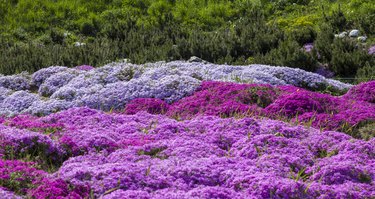Russian sage (Salvia yangii, formerly Perovskia atriplicifolia) is a plant that grows in mixed borders, wildlife gardens, perennial borders, and other landscapes. It has spikes of tiny light blue flowers and gray-green leaves that are finely cut and smell good. This drought-tolerant, woody-based perennial is hardy in U. S. USDA plant hardiness zones 3 through 9, and it grows 3 to 4 feet tall and the same width across. Its two-lipped, tubular flowers appear in summer through fall.
With its aromatic gray-green foliage and vibrant purple blooms, Russian sage (Perovskia atriplicifolia) is a star player in both ornamental and edible gardens. As this hardy perennial begins to fade in fall, you can preserve its unique beauty through drying. Read on to learn easy methods for drying Russian sage so you can enjoy its silvery tones and texture all year long.
Why Dry Russian Sage?
Here are some top reasons for drying this garden favorite
- Prolong its life to display indoors as decoration
- Craft dried flower arrangements and wreaths
- Add interest to potpourri with its fragrance
- Use as everlasting filler in bouquets and centerpieces
- Accentuate holiday tablescapes and mantelpieces
When to Harvest Russian Sage for Drying
Cut fresh sprigs of Russian sage to dry in early fall when plants are in full bloom Choose stems with flowers in peak condition without browning. In the morning after dew dries but before the heat of midday is ideal timing
Use clean bypass pruners to snip stems just above leaf sets Remove any leaves that would sit in water when hydrating cuttings. Cut 6-12 inch long stems for easier drying
How to Dry Russian Sage Flowers and Foliage
Russian sage lends itself beautifully to a range of drying techniques. Experiment to find which you like best:
Air Drying
-
Gather 3-5 stems and secure at ends with a rubber band. Hang bundles upside down in a warm, dry, dark area with good air circulation.
-
Check bundles daily until fully dried in 1-2 weeks. Leaves should be crispy and flowers stiff.
-
Use as-is or remove rubber bands and gently separate for arrangements.
Sand Drying
-
Strip leaves from bottom half of stems.
-
Stand bundled stems in clean vases or jars filled with about 2 inches of sand, flowers above sand.
-
Sand keeps stems upright for air circulation while flowers dry.
-
Change sand every few days to prevent mold growth.
Silica Gel Drying
-
Place individual blooms face down on trays of silica gel (available online).
-
Flowers dry completely in 1-5 days depending on thickness.
-
Silica gel can be reused repeatedly.
Microwave Drying
-
Arrange flowers face down between paper towels.
-
Microwave on low in 30 second bursts checking between cycles.
-
Allow to fully cool before removing to prevent scorching.
-
Use for potpourri or crafts; won’t hold shape as well dried this way.
Oven Drying
-
Spread flowers and foliage on trays lined with parchment paper.
-
Heat oven to lowest setting, ideally under 125°F.
-
Prop door open slightly for air flow. Dry until crispy, about 30-60 minutes.
Tips for Drying Russian Sage Perfectly
Follow these expert tips for getting the best dried Russian sage every time:
-
Dry in a dark space to preserve colors. Light causes fading.
-
Allow ample warm, dry airflow around drying plants.
-
Check bundles daily and remove any moldy pieces immediately.
-
Dry flat botanicals between sheets of parchment or wax paper weighted down.
-
For hanging bundles, use breathable bags not plastic to prevent moisture buildup.
-
Natural bunches keep better than stripped leaves and petals.
-
Don’t overpack drying containers or bundles. Crowding causes mold.
-
If dust accumulates, gently wash dried plants under running water and re-dry.
What to Do with Dried Russian Sage
The uses for preserved Russian sage are endless! Here are some ideas:
-
Make fragrant wreaths and garlands for doors and mantels
-
Fill glass hurricanes and vases for table arrangements
-
Craft colorful potpourri mixes to scent room
-
Add bundles to displays as home decor accents
-
Mix into herbal teas, bath salts, and aromatherapy blends
-
Place single stems in small bud vases around the home
-
Glue delicate flowers onto candles, cards, packages, and DIY gifts
-
Fill sachets for drawer liners, closet fresheners, and sleep pillows
Storing Dried Russian Sage Long-Term
To enjoy dried Russian sage for years, store properly in an airtight container out of direct light and heat. Glass jars, tin boxes, and opaque plastic bags all work well for storage. Add a natural desiccant like silica gel packets to absorb moisture. For best longevity, avoid humidity and check periodically for moisture buildup.
With its interesting leaf texture and showy purple blooms, Russian sage earns a spot in any sunny garden. And by drying it each season, you can admire its unique beauty all through the winter. Experiment with different drying techniques to find your favorite methods for preserving this versatile plant. Let Russian sage lend its wreathy whimsy to your home decor for years to come!
Frequently Asked Questions About Drying Russian Sage
What’s the best time of year to dry Russian sage?
Late summer to early fall when plants are in peak bloom is ideal. The stems are more pliable and flowers at their brightest compared to later in fall.
How long does it take to fully dry Russian sage?
Drying time depends on method, bundling, and humidity levels. Plan for 1-2 weeks hanging to dry naturally. Quicker techniques like silica gel take 1-5 days.
Should you remove Russian sage leaves before drying?
Leaves help hold flower heads on but can be removed from the lower half of stems for quicker drying if desired. Keep some leaves for a natural look.
Does Russian sage keep its scent when dried?
The aromatic scent diminishes once dried but a hint remains. You can add a drop of essential oil to restore the smell if desired.
Can you dry Russian sage in the microwave?
Yes, microwave between paper towels on low in 30 second bursts. Let cool fully before removing to prevent scorching. Use dried blooms for crafts rather than full sprigs.
What’s the best way to dry Russian sage for wreaths?
Air drying bundles hung upside down works beautifully. Keep out of light so they don’t fade. The stems dry straight for easy wreath assembly.
How do you store dried Russian sage for the longest life?
Keep in cool, dark airtight containers like jars or opaque plastic bags with desiccant packs. Check for moisture and dust periodically. Avoid humidity.
Can you use dried Russian sage for potpourri?
Yes, the preserved fragrance and silver foliage add nice texture and color to potpourri mixes and sachets. Blend with other dried herbs and flowers.
Preserving Russian sage through drying allows you to admire its unique beauty year-round. Follow these tips to harness its aromatic elegance for all your decorating and crafting needs.
Household Uses of Sage
Sage used in cooking is not the same as Russian sage. Russian sage is a plant in the mint family (Lamiaceae). There are, however, still many Russian sage uses. It’s not very tasty to eat the Russian sage plant’s leaves, but the slightly spicy flowers can be eaten. The leaves can be used as a garnish or steeped in a tea that many say helps with stomach pain. You can also dry Russian sage leaves to make a fragrant potpourri. You can also dry complete stalks of the Russian sage plant for use in dried flower arrangements.



Cultivars of Russian sage have a range of uses in gardens too. Little Spire Russian sage, or Perovskia atriplicifolia Little Spire, grows to be about 1 1/2 to 2 feet tall and wide. It can be used to make paths and informal hedges. This compact plant also grows well in containers. Filigran Russian sage, or Perovskia Filigran, is 2 to 4 feet tall and 2 to 3 feet wide. Its lacy, silvery leaves look nice in an ornamental border. Longin Russian sage, or Perovskia Longin, is 3 to 4 feet tall and 2 to 3 feet wide. It grows straight up, which makes it a good vertical contrast to plants that are round and bushy. Little Spire, Filigran and Longin are hardy in USDA zones 5 through 9.
Perennial and Mixed Borders
Video of the Day
Russian sage does well in both perennial borders and mixed borders with bulbs, shrubs, evergreens, perennials, and other plants. When paired with evergreens, the plants blue flowers create an interesting color contrast. When the summer flowers die back, Russian sage stays tall in warm places and adds vertical interest to garden beds. For Russian sage, though, it can be hard to stand tall because it tends to fall over when it does. To prevent this, plant supportive plants around it and make sure the sage gets full sun.



Video of the Day
Plant Russian sage toward the back of the border, where it adds height and doesnt screen smaller plants. This perennial doesn’t need much care and can grow in dry, rocky, chalky, or alkaline soil. It also does well in coastal gardens because it can handle salt. Cut the plants back to 6 inches above the soil in the spring so that the new growth can flower. Use rubbing alcohol on a cloth to clean the pruning shear blades before and after cutting back Russian sage.
Russian sage looks great in natural wildlife gardens because it blooms in a hazy background all summer long and into September. This fragrant plant attracts butterflies and hummingbirds while resisting more destructive garden visitors like deer and rabbits. The fine, crowded stems of the plant offer shelter to beneficial insects as well. For a natural look, plant your Russian sage in odd-numbered groups of three, five or seven plants. For an interesting contrast, you could add more color by putting pink flowers with the sage.
7 Mind-Blowing Facts About Russian Sage You Won’t Believe! ✅ // Gardening Tips
- The Ultimate Guide to Growing Strawberries in Raised Beds - August 8, 2025
- No-Dig Garden Beds: The Easiest Way to Grow a Beautiful Garden - August 6, 2025
- How to Protect and Preserve Wood for Raised Garden Beds - August 6, 2025

